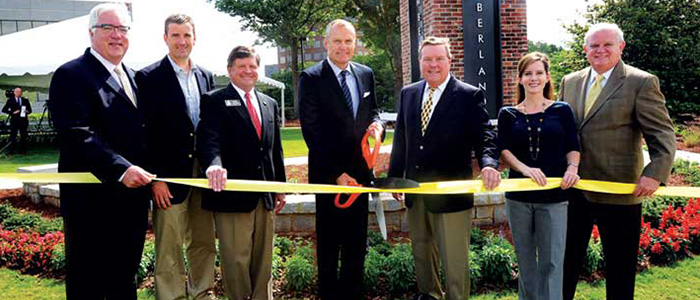
With a population of more than 700,000 people, Cobb County has proven itself to be a booming—and expanding—center for business and residential communities alike. In order to sustain these communities and support the growing population, a great deal of maintenance and improvement must be made within the county on a regular basis.
Cobb is home to two Community Improvement Districts, or CIDs; these are defined as groups of neighboring businesses that pay additional taxes in order to facilitate improvements within their area. One of Cobb’s CIDs is located in the Cumberland region, the other in the Town Center area. These divisions work both individually and collaboratively on projects to improve the look and quality of the areas in which we live and work.
Community Improvement Districts focus their efforts on increasing the levels of connectivity and reliable transportation avenues within an area to make for smoother movement and accessibility to those using that space. Through research, studies of specific areas and input from the government and community, CIDs organize and carry out projects that benefit all members of the community.
What Do CIDs Do?
In the mid-1980s, Georgia legislature created and passed a CID law that allowed for commercial properties to pay additional taxes and leverage that money to benefit the community. These improvements consist of a wide variety of construction and enrichment that is often overlooked by the average passerby, and include infrastructure-related construction, such as the realignment of roads and sidewalks, and the building of bridges, highway connectors and interchanges. CIDs also complete projects such as adding trails to local parks and recreation areas, facilitating streetscape enhancement projects, contributing to the beautification and maintenance of those areas and providing outdoor waste containers and lighting.
“We find that in areas that have a CID, the property value always seems to go up,” says Lanie Shipp, executive director of the Town Center CID. “That’s because the place is taken care of. People would agree to pay the extra amount of tax because they know it will come back.” Shipp also explains that CIDs come in handy in more pressing times, such as during a recession, when the county is not as readily able to complete necessary improvement projects. She described the CID as a sort of “community keeper.”
How to Qualify
The businesses that make up a CID must be contiguous properties within the commercial districts, and must meet certain criteria in order for the law to apply.
Fifty-one percent of the property owners within the given district who represent 75 percent of the property value of that district must agree to pay the additional rate on top of their existing property taxes. In Cobb County, there is a limit of five additional mills of property taxes.
The money utilized for these various improvement projects is considered both public and private funds. The county collects the taxes and then returns it to the district, thus making the public funds private, and then the use for that money is determined. The Cumberland CID currently collects between $5 million and $6 million annually, according to their website.
A seven-member board of directors then partners with the Cobb County government in the planning and designing processes to decide what will be done with the collected funds. The Department of Transportation also plays a role in the process. “We must hold public meetings when federal money is used or any time there is a big project that’s going to impact a lot of people,” Shipp says. “You want that public input.”
Malaika Rivers, executive director of the Cumberland CID, saays that in the 25 years the Cumberland CID has been operating in Cobb County, approximately $100 million has been collected and more than 20 improvement projects have been completed. She explains that these results have helped shape Cobb into a more attractive hub for businesses and residents. “The Cumberland area is Cobb’s largest economic engine,” Rivers says. “With one of the largest convention centers, a regional performing arts center … (the CID) helps create infrastructure to grow Cobb’s most critical market.”
According to the Cumberland CID website, by 2018 they “will have committed more than $130 million and leveraged that into more infrastructure improvements.” Both the Cumberland and Town Center CIDs are home to not only many residents, but large businesses as well.
Cumberland, which is located right on the cusp of two major Georgia interstates, I-75 and I-285, maintains a steady amount of traffic on a daily basis. It is also home to numerous high-value properties. The Town Center area, which neighbors Kennesaw State University, also sustains a great deal of both automobile and foot traffic. KSU has student population of 25,000 and 3,000 staff and faculty members. “The population of students and faculty at KSU is a larger population than Kennesaw and Acworth put together,” Shipp says. “There is a lot of student activity in the area. We try to connect everything together.”
Coming Soon to a Community Near You
Improvements that are planned and delivered by the Cobb County CIDs are primarily multi-year projects. The typical project takes approximately seven years from the planning and designing stages to completion.
Currently, the Town Center CID is working on the construction of a bridge that will link the Kennesaw State University campus on the west side of I-75 to an office park on the east side of the interstate. The bridge will have both pedestrian and automobile access and will be lighted, a positive safety measure that will be an advantage to those using the structure at night. “We have so many young people (in Kennesaw) who do ride bicycles and walk on the trails,” Shipp says. “We work on the connectivity so people can get around without using their cars.”
Not only will this bridge be beneficial to Kennesaw residents, but it will have a huge impact on the student population at KSU. For those students who do not have a car, this bridge will provide a great convenience. The project, which is estimated to cost $17 million, is expected to break ground in October of this year and should be completed by 2015.
Shipp also says that she expects the Noonday Creek Trail, a seven-mile trail stretching from Kennesaw Mountain Park to Johnson Ferry Road, will be completed in June 2014. “That one connection will go from the mountain to the south, pick up the Silver Comet Trail and go all the way down to Cumberland and the Chattahoochee,” Shipp says. This project is a joint effort of the Town Center CID, Cobb County, the Georgia DOT and the National Park Service, according to the Town Center CID website. It includes five pedestrian bridges with access to trailheads and parking.
Both the Town Center and Cumberland CIDs are dedicated to improving not only the aesthetic and infrastructural values of the Cobb County community, but the quality of life for those who live and work in the area as well. Their efforts of “connecting people and places” have contributed significantly to the economic strength and appeal of the Cobb County community and continue to help grow the sense of esteem and worth it holds.














